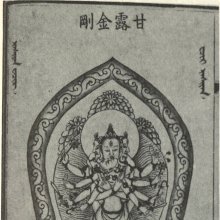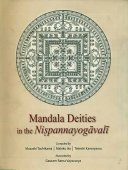Vajramrita, Vajrāmṛta, Vajra-amrita: 2 definitions
Introduction:
Vajramrita means something in Buddhism, Pali. If you want to know the exact meaning, history, etymology or English translation of this term then check out the descriptions on this page. Add your comment or reference to a book if you want to contribute to this summary article.
The Sanskrit term Vajrāmṛta can be transliterated into English as Vajramrta or Vajramrita, using the IAST transliteration scheme (?).
Images (photo gallery)
In Buddhism
Tibetan Buddhism (Vajrayana or tantric Buddhism)
Source: archive.org: The Indian Buddhist IconographyVajrāmṛta (वज्रामृत) refers to one of the various emanations of Amoghasiddhi, commonly depicted in Buddhist Iconography, and mentioned in the 11th-century Niṣpannayogāvalī of Mahāpaṇḍita Abhayākara.—His Colour is green; he has three faces and six arms.—Vajrāmṛta is the principal deity in the vajrāmṛtamaṇḍala of the Niṣpannayogāvalī.
Vajrāmṛta is described in the Niṣpannayogāvalī as follows:—
Source: De Gruyter: A Fragment of the Vajrāmṛtamahātantra“Vajrāmṛta sits on a sattvaparyaṅka and is green like the Priyaṅgu flower. He is three-faced, the right and left faces show the white and red colour. He is six-armed. The two principal hands holding the vajra, and the ghaṇṭa, embrace the prajñā of his own creation. The two other right hands carry the discus and the sword, and the two left show the noose and the goad.”
Vajrāmṛta (वज्रामृत) is another name for the Vajrāmṛtamahātantra or Vajrāmṛtamahātantra, representing one of the main and earliest Buddhist Yoginītantras, probably datable to between the end of the 9th and the beginning of the 10th century. The text consists of a dialogue between a questioner and a/the Buddha or Bhagavān (in this work called Vajrin, Vajrāmṛta, and Mahāsukha), who imparts the teaching. Following a well-established scheme, which here is probably modelled after the Śaiva tantras, in this text the questioner is identified with the female consort of the Bhagavān instead of one of the Bodhisattvas, who are usually the recipients of the Tantric teachings.
Vajrāmṛta as a is deity described in the ‘geyanṛtyābhiṣeka-tattvāvabodha’ chapter of the 9th-century Vajrāmṛtatantra or Vajrāmṛtamahātantra: one of the main and earliest Buddhist Yoginītantras. Chapter 7 starts with a praise of Vajrāmṛta sung by Māmakī, who is still involved in the love play with him, while joining her hollowed palms in reverence. This song contains a description of Vajrāmṛta, who is defined as a hero encircled by other heroes, who is joined by the group of Mudrās; he emits a sound similar to that of kokilas and bees, he is goodlooking, and he experiences the pleasure of love; he is omniscient and friendly towards all beings; his body hair is bristled; and he makes love to the 24 Great Wisdoms (Tārā, Vitārā, etc.) in all three spheres of existence.
The praise ends with two Apabhraṃśa stanzas, which read: “You, dark like a petal of a blue waterlily, are the Tathāgata, the Vajra-holder. Oh Pleasure of Sexual Delight, love me! By means of that you accomplish [your] duty in the three worlds. You are empty, pure, the supreme stage, the unchanging Vajra, beginningless. The living being—either moving or unmoving—who meditates on you, how can he be born again in the saṃsāra?”.

Tibetan Buddhism includes schools such as Nyingma, Kadampa, Kagyu and Gelug. Their primary canon of literature is divided in two broad categories: The Kangyur, which consists of Buddha’s words, and the Tengyur, which includes commentaries from various sources. Esotericism and tantra techniques (vajrayāna) are collected indepently.
See also (Relevant definitions)
Partial matches: Amrita, Vajra.
Starts with: Vajramritamahatantra, Vajramritatantra.
Full-text: Vajramritamahatantra, Vajrasattvamandala, Geyanrityabhishekatattvāvabodha, Shashimandala, Candri, Manohladanakari, Saumya, Manojna, Shashini, Saumyavadana, Shashilekhya, Guhyamandalakaranabhinaya, Vajramritatantra, Pancamritasadhanopaya, Vajrahumkara, Vajrahumkarasadhana.
Relevant text
Search found 2 books and stories containing Vajramrita, Vajra-amṛta, Vajrāmṛta, Vajra-amrita, Vajramrta, Vajra-amrta; (plurals include: Vajramritas, amṛtas, Vajrāmṛtas, amritas, Vajramrtas, amrtas). You can also click to the full overview containing English textual excerpts. Below are direct links for the most relevant articles:
Guhyagarbha Tantra (with Commentary) (by Gyurme Dorje)
Blue Annals (deb-ther sngon-po) (by George N. Roerich)
Chapter 1c - The Zur Geneology (vii): Lha rje lce ston rgya nag < [Book 3 - Early translations of Secret Mantra]
Related products

